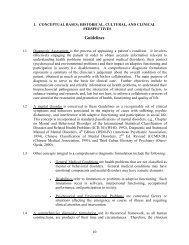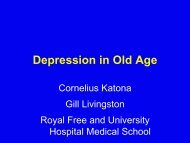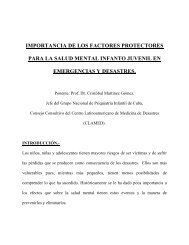ABSTRACTS - World Psychiatric Association
ABSTRACTS - World Psychiatric Association
ABSTRACTS - World Psychiatric Association
Create successful ePaper yourself
Turn your PDF publications into a flip-book with our unique Google optimized e-Paper software.
American countries, that the majority of adults with common mental<br />
disorders do not seek care for mental health reasons. However, examination<br />
of administrative databases as part of an effort to establish a<br />
Canadian national mental health surveillance system like for diabetes,<br />
provide a different picture of primary and specialist de facto<br />
system. CCHS 1.2 showed, over the course of one year, that about 5%<br />
of Canadians, with little variation across provinces, reported seeing a<br />
general practitioner for mental health reasons; and that about 40%<br />
reported seeing a health professional for mental health reasons if they<br />
showed symptoms of DSM-IV anxiety, depressive or substance abuse<br />
disorders. However, examination of physician billings administrative<br />
databases in five Canadian provinces indicated that over 15% of the<br />
population were identified with a mental disorder, essentially anxiety<br />
or depressive disorders, in the course of one year. Over the course of<br />
3 to 5 years, nearly one third of the population was identified. The latter<br />
is closed to lifetime prevalence of common mental disorders. In<br />
the urban area of Montreal, a city of 1.8 million inhabitants, administrative<br />
databases used for surveillance and planning allowed to delineate<br />
that primary care general practitioners were solely involved for<br />
the majority of people identified with anxiety disorders and half of<br />
those with depressive disorders, but that specialist services were<br />
involved in over 80% of those diagnosed by at least one physician<br />
with schizophrenia. The implications of the findings will be discussed:<br />
a) the myth in Canada that primary care general practitioners<br />
do not identify and treat the majority of their patients with common<br />
mental disorders; b) the ‘de facto’ Canadian system where patients<br />
with the most severe disorders are seen by specialists and where<br />
depression is the condition in which most shared mental health care<br />
seems to occur; c) the fact that challenge for mental health care based<br />
in primary care is not detection, but quality of care, including access<br />
to all forms of potentially effective treatments.<br />
ZS9.3.<br />
IMPLEMENTING MENTAL HEALTH REFORM<br />
IN CANADA: DEVELOPMENT OF COORDINATED<br />
ACCESS TO HOSPITAL AND COMMUNITY<br />
SERVICES<br />
R. Milev, K. Carmichael, A. Mathany, P. Kennedy<br />
Department of Psychiatry, Queen’s University, Kingston,<br />
Ontario, Canada<br />
According to government policies, mental health care in Canada is<br />
seen as a continuum of services, provided at three levels: first line<br />
(primary), intensive, and specialized (tertiary) services. Given the<br />
numerous providers of mental health services, it is sometimes challenging<br />
to achieve the integration required for a seamless and efficient<br />
care. We examine the process used to develop a system-wide coordinated<br />
access to mental health and addiction services in a geographically<br />
defined area in Ontario, Canada. Development of a common<br />
referral form and release of information consent form were amongst<br />
the first steps completed to implement coordinated access. Commitment<br />
to the principle of “best fit/match” introduced a review process<br />
to ensure that, with very few exceptions, individuals referred for mental<br />
health or addiction services received care from one or more of the<br />
service providers. Some outcome measures, such as wait time for an<br />
appointment, patient and referral sources’ satisfaction etc., have been<br />
monitored. Common standards for initial risk assessments, and routine<br />
clinical examinations will be determined as the work progresses.<br />
A variety of measures to ensure patient flow, such as regular review of<br />
patient loads, step-down to other services or primary care etc., assure<br />
the ability of each service to provide the most efficient care.<br />
ZS9.4.<br />
EVALUATING MENTAL HEALTH REFORM<br />
IN CANADA<br />
H. Stuart, T. Krupa, M. Koller<br />
Department of Community Health and Epidemiology, Queen’s<br />
University, Kingston, Ontario, Canada<br />
By the late 1960s, Canada’s asylum bed capacity had reached its<br />
zenith, with almost 77,000 beds. Over the next two decades, these<br />
were reduced by 70%. Health ministries were increasingly investing<br />
in general hospital psychiatric beds and community based services. In<br />
2001, in preparation for a second wave of bed closures, the Ontario<br />
Ministry of Health funded a series of surveys to assess the system’s<br />
capacity to provide additional community services to patients scheduled<br />
for resettlement. In our region, only about a third of clients<br />
received an intensity of care that matched their clinical needs. Agencies<br />
subsequently received additional funding to enhance intensive<br />
community based services and supports. In 2006, we replicated our<br />
original study to determine whether clients were receiving more<br />
appropriate care and using fewer hospital resources following the<br />
receipt of funding for system enhancement. This paper highlights the<br />
methods used to evaluate system-wide reforms and summarizes the<br />
findings from these evaluations.<br />
ZS9.5.<br />
THE MENTAL HEALTH REFORM AND TEACHING<br />
OF PSYCHIATRIC RESIDENTS<br />
R. Tempier<br />
University of Saskatchewan, Canada<br />
The new Mental Health Commission of Canada (MHCC) has recently<br />
launched three key initiatives: an anti-stigma campaign, a national<br />
strategy for mental health and a knowledge exchange centre (KEC).<br />
The anti-stigma campaign should be based on strong education principles<br />
and will last for the next 10 years, aiming to show that mental<br />
illness is an illness like others. The KEC should bring to the public<br />
evidence-based best practice information on areas of need. <strong>Psychiatric</strong><br />
residents, according to the Royal College of Physicians and Surgeons<br />
of Canada (RCPSC), should identify and appropriately respond<br />
to stigma, long-term illness and rehabilitation. The RCPSC states that<br />
psychiatrists need to be proficient in systems of care and delivery, and<br />
that residents should be skilled on how to address the increasing need<br />
for psychiatric services to work more closely with primary care<br />
providers. Finally, as medical experts, future psychiatrists will be<br />
health advocates advancing the health and well-being of patients,<br />
community and populations and have a leadership role in mental<br />
health services. We will envision on whether the MHCC, and the possible<br />
consequent reforms that could potentially follow, will have an<br />
impact on psychiatric education, and if yes, what will be the magnitude<br />
of such an impact.<br />
128 <strong>World</strong> Psychiatry 8:S1 - February 2009

















